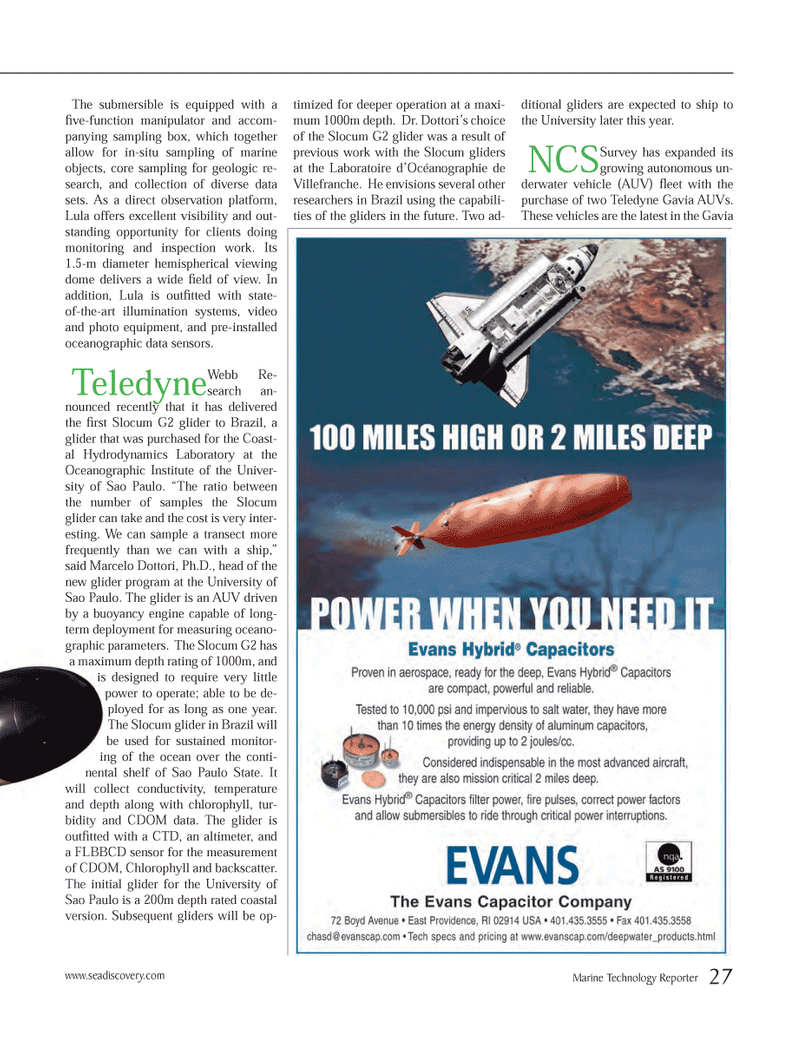
Page 27: of Marine Technology Magazine (January 2013)
Subsea Vehicle Report: Unmanned Underwater System
Read this page in Pdf, Flash or Html5 edition of January 2013 Marine Technology Magazine
The submersible is equipped with a Þ ve-function manipulator and accom- panying sampling box, which together allow for in-situ sampling of marine objects, core sampling for geologic re-search, and collection of diverse data sets. As a direct observation platform, Lula offers excellent visibility and out- standing opportunity for clients doing monitoring and inspection work. Its 1.5-m diameter hemispherical viewing dome delivers a wide Þ eld of view. In addition, Lula is outÞ tted with state- of-the-art illumination systems, video and photo equipment, and pre-installed oceanographic data sensors. Teledyne Webb Re- search an-nounced recently that it has delivered the Þ rst Slocum G2 glider to Brazil, a glider that was purchased for the Coast- al Hydrodynamics Laboratory at the Oceanographic Institute of the Univer- sity of Sao Paulo. ÒThe ratio between the number of samples the Slocum glider can take and the cost is very inter- esting. We can sample a transect more frequently than we can with a ship,Ó said Marcelo Dottori, Ph.D., head of the new glider program at the University of Sao Paulo. The glider is an AUV driven by a buoyancy engine capable of long- term deployment for measuring oceano- graphic parameters. The Slocum G2 has a maximum depth rating of 1000m, and is designed to require very little power to operate; able to be de- ployed for as long as one year. The Slocum glider in Brazil will be used for sustained monitor- ing of the ocean over the conti- nental shelf of Sao Paulo State. It will collect conductivity, temperature and depth along with chlorophyll, tur- bidity and CDOM data. The glider is outÞ tted with a CTD, an altimeter, and a FLBBCD sensor for the measurement of CDOM, Chlorophyll and backscatter. The initial glider for the University of Sao Paulo is a 200m depth rated coastal version. Subsequent gliders will be op- timized for deeper operation at a maxi-mum 1000m depth. Dr. DottoriÕs choice of the Slocum G2 glider was a result of previous work with the Slocum gliders at the Laboratoire dÕOc?anographie de Villefranche. He envisions several other researchers in Brazil using the capabili-ties of the gliders in the future. Two ad- ditional gliders are expected to ship to the University later this year. NCS Survey has expanded its growing autonomous un- derwater vehicle (AUV) ß eet with the purchase of two Teledyne Gavia AUVs. These vehicles are the latest in the Gavia Marine Technology Reporter 27www.seadiscovery.com MTR #1 (18-33).indd 27MTR #1 (18-33).indd 271/30/2013 10:20:05 AM1/30/2013 10:20:05 AM

 26
26

 28
28
